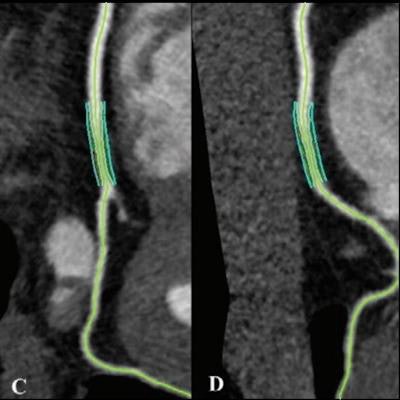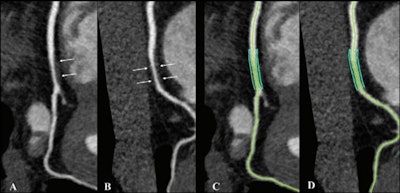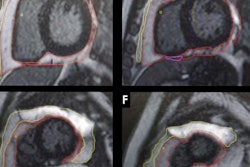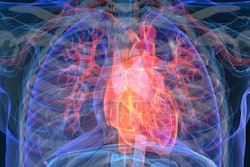
Coronary CT angiography (CCTA) scans show that individuals who are positive for HIV who are not known to have heart disease have more than three times the burden of noncalcified coronary plaque than people without the virus, according to a study published April 20 in Radiology.
The study highlights the need for HIV-positive people to be carefully monitored, and CCTA is a good modality for this application, wrote a team led by senior author Dr. Carl Chartrand-Lefebvre of the University of Montreal Hospital in Canada. Noncalcified plaque is associated with higher all-cause mortality risk, the authors noted.
"Our results suggest that noncalcified plaque is involved as an anatomic substrate in the higher risk of cardiovascular disease in people living with HIV, and CT should be considered a noninvasive imaging option of choice in further clinical, prognostic, and mechanistic studies of HIV-associated atherosclerosis," they wrote.
 Noncalcified coronary plaque in an asymptomatic 52-year-old man living with HIV with a 10-year Framingham risk of 5%. Images show 256-section contrast-enhanced coronary CT angiography with electrocardiographic gating and curve reformat. (A, B) CT scan shows a smooth noncalcified plaque in the right coronary artery (arrows) with 70%-80% stenosis. (C, D) The right coronary artery plaque volume was 130 mm3 (green lines).
Noncalcified coronary plaque in an asymptomatic 52-year-old man living with HIV with a 10-year Framingham risk of 5%. Images show 256-section contrast-enhanced coronary CT angiography with electrocardiographic gating and curve reformat. (A, B) CT scan shows a smooth noncalcified plaque in the right coronary artery (arrows) with 70%-80% stenosis. (C, D) The right coronary artery plaque volume was 130 mm3 (green lines).In part due to antiretroviral therapy, people with HIV are living longer and thus may experience age-related conditions such as coronary artery disease, the group wrote. Studies have suggested that they have a greater risk of heart attack than people who aren't infected, but the reasons for this are unclear. Inflammation and immune dysfunction could play a role.
CCTA offers a noninvasive imaging option for monitoring heart disease risk in those with HIV. In their new study, Chartrand-Lefebvre and colleagues explored whether CCTA could measure coronary plaque burden in people with HIV without heart disease symptoms, compared with people who weren't infected.
The study included data taken from a pool of 265 people who underwent noncontrast CT with coronary artery calcium scoring between 2012 and 2019; of the study cohort, 181 were HIV-positive and 84 were uninfected volunteers. In the HIV-positive group, 155 people underwent CCTA, while in the control group, 78 underwent this exam.
The researchers found no significant difference between the two participant cohorts when it came to cardiovascular risk scores. But people living with HIV had a more than three times higher prevalence of noncalcified plaque than their healthy counterparts.
| Noncalcified plaque prevalence in non-HIV- and HIV-positive people | ||
| Plaque type | Non-HIV-positive participants | HIV-positive participants |
| Any | 60.2% | 70.3% |
| Calcified | 50% | 45.2% |
| Noncalcified | 7.7% | 21.9% |
| Mixed | 32% | 49% |
The study findings underscore the importance of monitoring the heart health of HIV-positive people, wrote Dr. Shenhan Lai of the University of Maryland in Baltimore in an accompanying editorial.
"At present, HIV cannot be cured and continues to be a major global health challenge," he wrote. "HIV should be treated as a nonmodifiable risk factor for coronary artery disease and other comorbidities. ... To prevent and slow HIV-associated coronary atherosclerosis, those with HIV infection must aggressively manage both traditional and untraditional risk factors for coronary atherosclerosis."





















